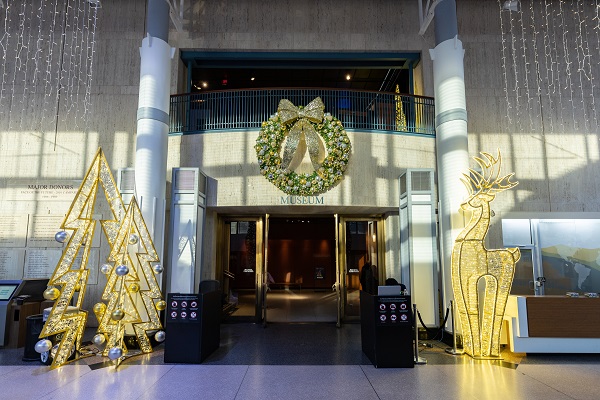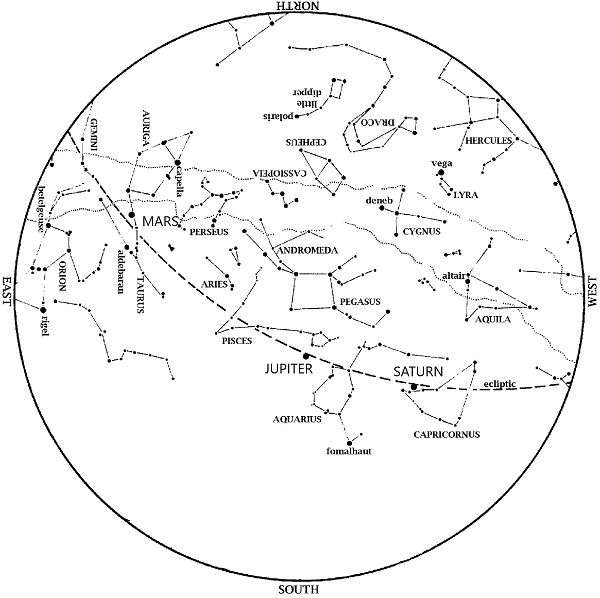Editor’s Note: Look to the skies as HMNS Astronomer James Wooten explains the sky happenings for the month of December, including the science behind our winter solstice.
Jupiter is still in the evening sky; look for it in the south at nightfall. Jupiter is brighter than any star we ever see at night.
Saturn remains well placed for observing in the southwest at nightfall.
Mars is up all night long this month! On Wednesday, December 7, Earth passes between Mars and the Sun. This puts the Sun and Mars on opposite sides of the Earth, and alignment called opposition. Any planet at opposition is up literally all night long. Until just before Christmas, Mars will be brighter than any star we ever see at night. However, Mars won’t get quite as bright as Jupiter, or as bright as Mars itself was back in 2020 or 2018. Mars is slightly farther from the Sun than it was when Earth overtook it in those years, so Earth can’t approach Mars as closely as it did then.
Venus emerges into the evening sky this month. Look for it late in the month low in the west in twilight, over the point of sunset. This gets easier between Christmas Day and New Year’s Eve.
Mercury also enters the evening sky ahead of Venus this month. Mercury will appear above and slight to the left of Venus as they both set right after the Sun. They are closest together the night of December 29, as Mercury is heading back towards the Sun’s glare.

The Summer Triangle sets in the west. Watch for the Great Square of Pegasus almost overhead at dusk now and in the west by Christmas. Taurus, the Bull rises in the east, with Mars in his horns. Look for the Pleiades star cluster above reddish Aldebaran. Dazzling Orion, the Hunter rises shortly after dusk (by month’s end, it is already up at dusk). As Orion enters the evening sky, we transition from the relatively dim evening skies of autumn to the brilliant stars of winter. We are beginning to face away from the center of the galaxy, looking at stars behind us in our own part of our galaxy (the Orion Spur).

The Summer Triangle sets in the west. The Great Square of Pegasus is high in overhead. Across the southern sky, we see a region of only dim stars, where only Fomalhaut stands out. Jupiter is in the south, while Saturn is in the southwest at dusk. Taurus, the Bull, rises in the east, joined by Orion, the Hunter. These stars herald the coming winter. Mars, in Taurus, is up all night long.
Moon Phases in December 2022:
Full Dec. 7, 10:08 p.m.
Last Quarter Dec. 16, 2:56 a.m.
New Dec. 23, 4:17 a.m.
1st Quarter Dec. 29, 7:20 p.m.
At 3:48 pm on Wednesday, December 21, the Sun is overhead as seen from the tropic of Capricorn, the farthest point south where this is possible. That’s because Earth’s North Pole is now tilted as far as possible away from the Sun. That’s why this is our winter solstice, the day when we have more night and less daylight than any other. Below the equator, this is the summer solstice because the South Pole is tilted towards the Sun as much as possible.
You will notice, however, that sunset on New Year’s Eve is up to ten minutes later than on December 1. Why, if the 31st is closer to the solstice? Although the shortest day (least daylight) occurs on December 21, the earliest sunset occurs for us about December 1. This is because the Sun’s apparent positon in our sky varies like a sine wave; there is little difference in the Sun’s apparent height for about a month before and after the solstice. Due to Earth’s tilt, the Sun does indeed take a shorter, lower path across the sky on December 21 than on December 1, but only by about 1.5 degrees (your pinky at arm’s length blocks one degree). Meanwhile, Earth is slightly accelerating as it approaches perihelion just after the new year. This makes both sunrise and sunset happen a little earlier each night during December. Near the solstice, this small effect can dominate. Since most of us sleep through sunrise and watch sunset, days seem to lengthen from December 1-21 when they are in fact still getting shorter.

Artemis 1, a test flight of the craft that will return humans to the Moon, remains in orbit around the Moon. Its Orion spacecraft is scheduled to leave its Distant Retrograde Orbit around the Moon on December 1. Then Orion will make a close flyby of less than 80 miles above the Moon’ surface, putting on a path to return to Earth for a splashdown on Sunday, December 11.
Our George Observatory is now open every Saturday night for observing! Purchase tickets in advance on our website.
Clear Skies!
Miss last month’s sky happenings? See them here.






